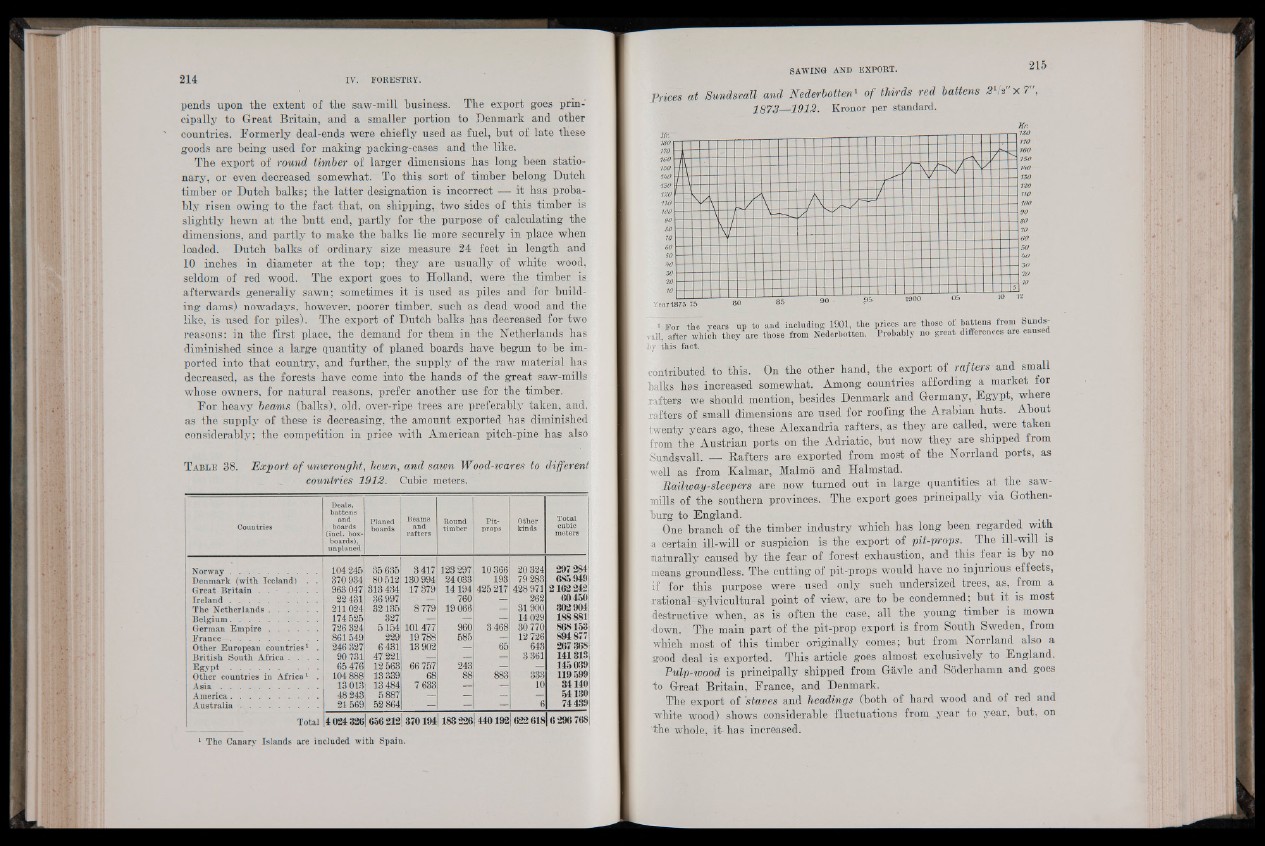
pends upon the extent of the saw-mill business. The export goes principally
to Great Britain, and a smaller portion to Denmark and other
countries. Formerly deal-ends were chiefly used as fuel, but of late these
goods are being used for making packing-cases and the like.
The export of round timber of larger dimensions has long been stationary,
or even decreased somewhat. To this sort of timber belong Dutch
timber or Dutch balks; the latter designation is incorrect — it has probably
risen owing to the fact that, on shipping, two sides of this timber is
slightly hewn at the butt end, partly for the purpose of calculating the
dimensions, and partly to make the balks lie more securely in place when
loaded. Dutch balks of ordinary size measure 24 feet in length and
1 0 inches in diameter at the top; they are usually of white wood,
seldom of red wood. The export goes to Holland, were the timber is
afterwards generally sawn; sometimes it is used as piles and for building
dams) nowadays, however, poorer timber, such as dead wood and the
like, is used for piles). The export of Dutch balks has decreased for two
reasons: in the first place, the demand for them in the Netherlands has
diminished since a large quantity of planed boards have begun to be imported
into that country, and further, the supply of the raw material has
decreased, as the forests have come into the hands of the great saw-mills
whose owners, for natural reasons, prefer another use for the timber.
For heavy beams (balks), old, over-ripe trees are preferably taken, and,
as the supply of these is decreasing, the amount exported has diminished
considerably; the competition in price with American pitch-pine has also
T a b l e 38. Export of unwrought, hewn, and sawn Wood-wares to different
countries 1912. Cubic meters.
Countries
Deals,
battens
and
boards
(incl. box-
boards),
unplaned
Planed
boards
Beams
and
rafters
Bound
timber
Pitprops
Other
kinds
Total
cubic
meters
Norway................................... 104 245 35 635 3 417 123 297 10 366 20 324 297 284
Denmark (with Iceland) . . 370 934 80 512 130 994 24 033 193 79 283 685 949
Great Britain . . . . . . 963 047 313 434 17 379 14 194 425 217 428 971 2 162 242
I r e la n d .................................... 22 431 36 997 HHii 760 — 262 60 450
The Netherlands.................... 211024 32135 8 779 19 066 — 31900 302904
Belgium.................................... 174 525 327 _ — — 14 029 188881
German E m p ire .................... 726 324 5154 101477 960 3 468 30770 868153
France .................................... 861 549 229 19 788 585 |||¡ ¡ ¡ 12 726 894877
Other European countries1 . 246 327 6 431 13902 H b 65 643 267 368
British South Africa . . . . 90 731 47 221 — — 3 361 141313
Egypt .................................... 65 476 12 563 66 757 243 1 ■ ! H Ü I 145 039
Other countries in Africa1 . 104888 13 339 68 88 883 333 119599
A s i a ........................................ 13 013 13 484 7 633 — = —- 10 34140
America.................................... 48 242 5 887 M s — — 54130
A u s tra lia ............................... 215691 52 864 — — 6 74439
Total 4 024 326 656 212 370194 183 226 440192 622 618 6 296 768
1 The Canary Islands are included with Spain.
Prices at Sundsvall and Nederbotten1 of thirds red battens 2 lh" X 7",
1873—1912. Kronor per standard.
Y e a r 1 8 7 3 75
1 For the years up to and including 1901, the prices are those of battens from Sunds-
v a l after which they are those from Nederbotten. Probably no great differences are caused
contributed to this. On the other hand, the export of rafters and small
balks has increased somewhat. Among countries affording a market for
rafters we should mention, besides Denmark and Germany, Egypt, where
rafters of small dimensions are used for roofing the Arabian huts. About
twenty years ago, these Alexandria rafters, as they are called, were taken
from the Austrian ports on the Adriatic, but now they are shipped from
Sundsvall. Rafters are exported from most of the Norrland ports, as
well as from Kalmar, Malmo and Halmstad.
Railway-sleepers are now turned out in large quantities at the sawmills
of the southern provinces. The export goes principally via Gothenburg
to England.
One branch of the timber industry which has long been regarded with
a certain ill-will or suspicion is the export of pit-props. The ill-will is
naturally caused by the fear of forest exhaustion, and this fear is by no
means groundless. The cutting of pit-props would have no injurious effects,
if for this purpose were used only such undersized trees, as, from a
rational'sylvicultural point of view, are to be condemned; but it is most
destructive when, as is often the case, all the young timber is mown
down. The main part of the pit-prop export is from South Sweden, from
which most of this timber originally comes; but from Norrland also a
good deal is exported. This article goes almost exclusively to England.
Pulp-wood is principally shipped from Gavle and Soderhamn and goes
"to Great Britain, France, and Denmark.
The export of staves and headings (both of hard wood and of red and
white wood) shows considerable fluctuations from year to year, but, on
the whole, it has increased.